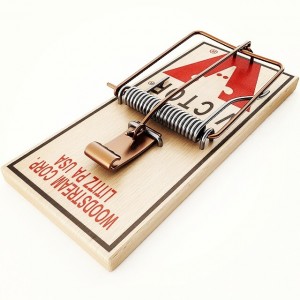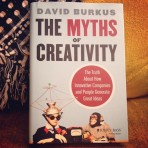Twitter Summary: No matter how awesome your new idea may be or how many problems it solves, you still have to convince the world you’re worth it.
Principle
Last week I shared the primary theme from David Burkus’ book The Myths of Creativity, which is that anyone and everyone can be creative. Over the next few posts I’m doing to dig into some of the specific myths Burkus debunks and the great examples he uses to do so.
Today I want to write about what Burkus calls the Mousetrap Myth. A lot of us believe that if you build the next greatest mousetrap, “getting others to see its value [will be] the easy part, and that if you develop a great idea, the world will willing embrace it.” In other words, we erroneously believe the world will beat a path to our door if we create something of creative value.
Burkus says, the reality is that “even if you build a better mousetrap, there is still a lot of work involved in selling the world on your new design.” No matter how awesome your new idea may be or how many problems it solves, you still have to convince the world you’re worth it.
Burkus shares the story of Admiral William Sowden Sims of the U.S. Navy to make his point. Sims discovered a way to dramatically improve the accuracy and efficiency of gun fire at sea. Gun fire at sea up to that point had been difficult due to rolling oceans. Deck mounted guns had to take aim at a target then adjust for the elevation of the target. The shooter would then have to wait for the waves of the ocean to put the target back into it’s sights, then fire. Obviously this caused a number of problems for accuracy and speed when it came to firing.
Sims had observed one man during target practice who was able to compensate for the rolling of the waves and was able to constantly shoot accurately, regardless of the rolling waves. Keeping his hands constantly on the elevating gear of the gun, this man was able to make subtle adjustments that allowed him to keep his target in his sights while the ship bounced on the waves of the sea. He shot better than anyone else and Sims noticed.
“Sims knew he had stumbled on an outstanding method and tried immediately to share that method with the entire American fleet. But the fleet’s senior leaders showed little of the excitement Sim had for the innovation. In fact, they showed none.”
Sims filed multiple reports justifying the change in tactics, demonstrating the value of his suggestions. His reports were dismissed, ignored, filed away, and no one took the time to respond to his claims. He began sending reports to other officers in the fleet to spread the word, hoping seniors in Washington would have to respond. He never received the response he had hoped for.
Eventually, Sims wrote a final report to President Theodore Roosevelt along with a letter explaining himself, his ideas, and the obstacles he faced in getting his idea implemented across the Navy. The result, Roosevelt promoted Sims to the inspector of target practice for the entire Navy where Sims was finally in a position to implement his method. After 6-years in that position, Sims was known as “the man who taught us how to shoot.”
In the end, people need to know if the value promised by the new idea is worth abandoning old ways. We all fear change, therefore we fear the things that ask us to change.
Convince The World You’re Worth It and Making Connections
In one of my many jobs, I remember looking at my email inbox and I was overwhelmed with a desire to press select all-delete. I was inundated with emails from everyone in the organization, very few of which had anything to do with my duties. I spent a good portion of my mornings sifting through information everyone was pushing out, trying to find the relatively few things that required my attention. I thought, there has to be a better way.
As part of a much larger plan, I enlisted the help of a few of my co-workers to develop a new daily process for our team. I gave them an outline of what I thought was best and asked for their contributions. It was exciting to hear how much everyone agreed with some of our failures and my proposed solutions, but more importantly, I was excited to hear all their great suggestions that magnified what I had started.
One of the key pieces of our process was eliminating the mass distribution of information. In a world dominated by RSS feeds, blog subscriptions, and email sign ups, I was baffled that anyone is doing “direct mailing” of any kind anymore. How often do you run to your real mailbox saying, “I can’t wait to see what mail I received that I didn’t ask for!?” How is that any different from email? We waste everyone’s time with mass distribution. We now live in a world where the majority of our work can be posted and doesn’t require pushing.
We formatted our new process so that we posted our daily work online, which allowed those who cared to read it or were directly affected by our work to subscribe or come directly to us to access our information. I knew I couldn’t be the only person who wanted to punch their computer screen because they had too many unrelated emails. I really tried to focus on eliminating the unnecessary distribution, but more importantly the unnecessary inundation, of information people had to delete on a daily basis.
In the end we presented the process to our immediate supervisor and it was shelved, ignored, and considered unhelpful. I pressed and went one level above that person to get some traction. And it did. The process was allowed to be put into place as a pilot program, which in the end was implemented throughout our whole division even after I left that job. However, our direct supervisor refused to participate in the process, making it hard for the process to have the intended impact. We couldn’t believe someone didn’t see the extreme value of the new mousetrap we made!
So What?
If you have a great idea that you’re trying to push, know that you MUST be persistent if you want to change anyone’s mind. There are likely cultures, paychecks, and social structures built upon what you’re trying to change and that requires an act of the U.S. President like in the case of Sims or a persistent worker bee like me to get it done. And in the end, it still might not be enough. So you have to believe in what you’re doing and be persistent.
Next Weeks Post: There is no such thing as a “eureka” moment. How the stories of Newton, Einstein, and others are all BS.








This was just what I needed to hear today. Thanks. 🙂
Awesome!
Good. I like it. I agree with everything you said.
The only thing I don’t like is the line in bold: “No matter how awesome your new idea may be or how many problems it solves, you still have to convince the world you’re worth it.” The sentence left me unsettled when I read it the first time. On looking at it again I think I know why; it’s the vague, feel-good phrase “you’re worth it”. This gives unneeded authority to the person and not to the idea itself. This sentence moves the argument from the genius of the idea the the personal feelings of its designer.
Besides this line, the content was rich and poignant.
Thanks Matt. I guess I’d follow your comment up with another question: is a tool any good if it doesn’t serve a purpose? Great ideas must demonstrate they serve a purpose and the point of the whole post is to show, most people wont see the purpose of a new idea at first. You have to convince the world you’re worth it regardless of the value of the idea.